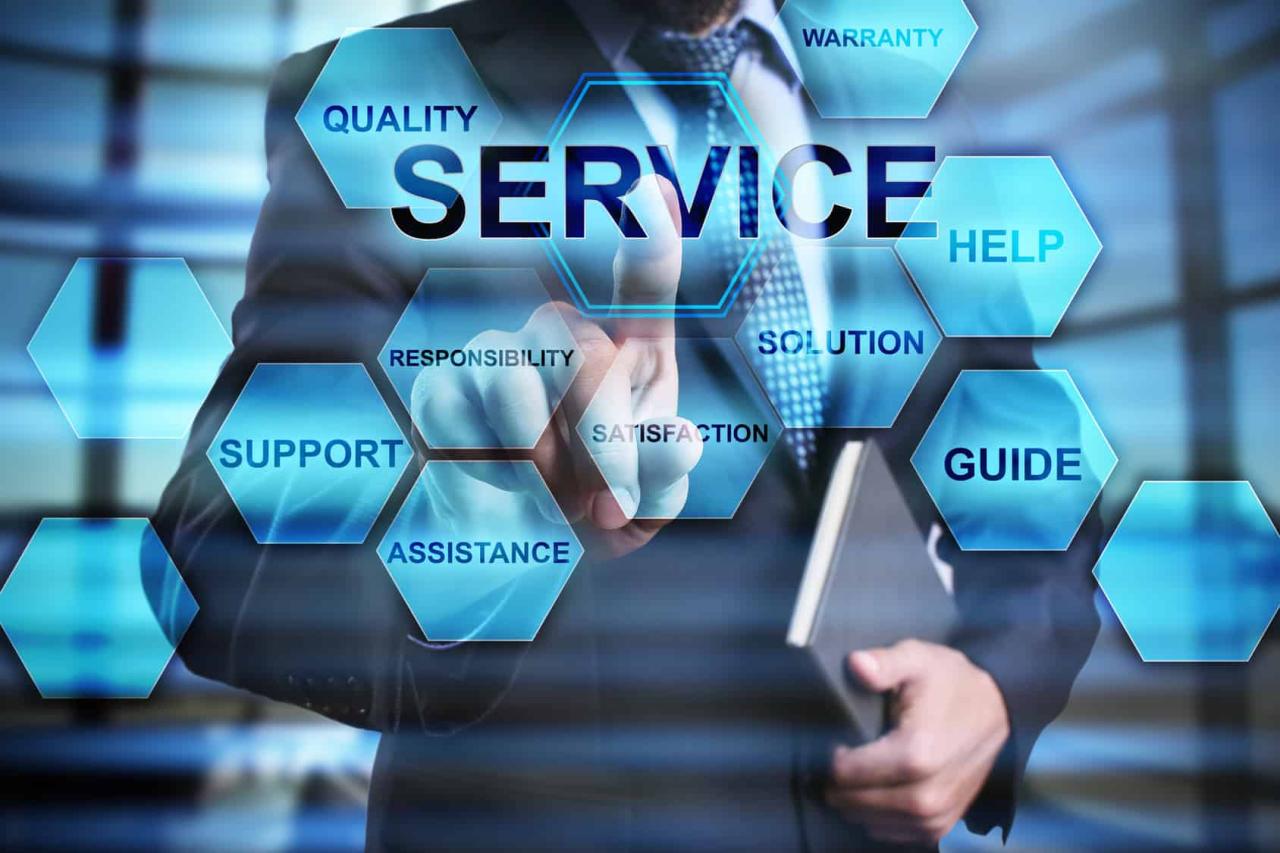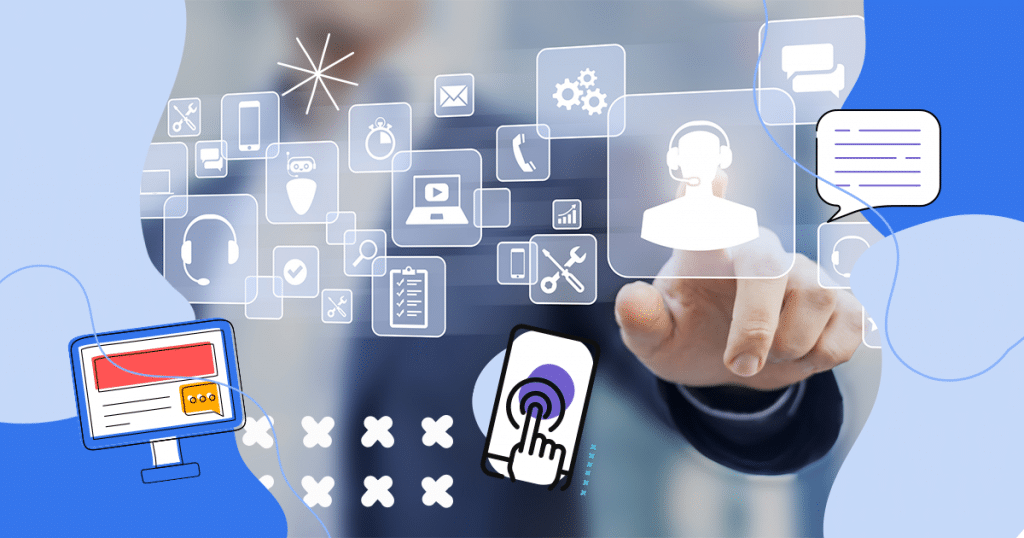Technology Customer Service: Revolutionizing Interactions
Technology customer service is transforming how businesses interact with their customers. From the days of phone calls and emails, we’ve transitioned to a digital landscape where AI-powered chatbots, self-service portals, […]

Technology customer service is transforming how businesses interact with their customers. From the days of phone calls and emails, we’ve transitioned to a digital landscape where AI-powered chatbots, self-service portals, and social media monitoring are changing the game. This evolution has led to faster resolution times, increased customer satisfaction, and greater efficiency for businesses.
The integration of technology has brought about a new era of customer service, empowering businesses to provide personalized experiences, anticipate customer needs, and resolve issues proactively. This shift has also presented new challenges, requiring businesses to adapt their strategies and ensure that their technology solutions are seamlessly integrated into their customer service workflows.
The Evolution of Technology Customer Service

Technology has revolutionized the way businesses interact with their customers, transforming the landscape of customer service from its humble beginnings to the sophisticated, AI-powered solutions we see today. This evolution has been marked by significant milestones and transformative technologies that have redefined the customer experience.
Traditional Customer Service Methods
Traditional customer service methods relied heavily on human interaction, often through phone calls, emails, and physical visits to brick-and-mortar stores. These methods, while effective in their time, were often slow, inefficient, and prone to human error.
- Phone Calls: Phone calls were the primary mode of communication, requiring customers to wait on hold for extended periods and potentially face long wait times to speak with a representative.
- Emails: Email communication was often slow, requiring multiple back-and-forth exchanges to resolve issues.
- Physical Visits: Physical visits to stores were necessary for in-person assistance, which could be time-consuming and inconvenient.
The Rise of Digital Customer Service
The advent of the internet and the widespread adoption of personal computers ushered in a new era of digital customer service. Websites, online forums, and email became popular channels for customer interaction, offering greater accessibility and convenience.
- Websites: Websites provided a platform for businesses to share information, offer self-service options, and provide FAQs.
- Online Forums: Online forums allowed customers to connect with each other and share experiences, fostering a sense of community.
- Email: Email communication became more efficient, with the ability to send and receive messages quickly.
The Impact of AI and ML on Customer Service
Artificial intelligence (AI) and machine learning (ML) have significantly transformed customer service, enabling businesses to provide more personalized, efficient, and scalable support.
- Chatbots: AI-powered chatbots can handle simple inquiries, provide quick answers, and automate repetitive tasks, freeing up human agents to focus on more complex issues.
- Predictive Analytics: ML algorithms can analyze customer data to anticipate needs and proactively offer solutions, enhancing customer satisfaction.
- Sentiment Analysis: AI can analyze customer feedback to identify trends and patterns, enabling businesses to improve their products and services.
The Future of Technology Customer Service
The future of technology customer service is likely to be driven by further advancements in AI and ML, with an emphasis on personalized experiences, proactive support, and seamless integration across multiple channels. Businesses will need to embrace these technologies to stay competitive and meet the evolving expectations of their customers.
Benefits of Technology-Driven Customer Service
Integrating technology into customer service operations offers numerous benefits, transforming how businesses interact with their customers. By leveraging technology, companies can enhance customer satisfaction, streamline operations, and gain a competitive edge in today’s digital landscape.
Increased Customer Satisfaction
Technology empowers businesses to provide personalized and efficient customer service experiences, leading to higher satisfaction levels. By leveraging customer data and analytics, companies can tailor interactions to individual needs, preferences, and past experiences. For example, chatbots can provide instant support, answer frequently asked questions, and guide customers through self-service options, reducing wait times and frustration.
- Personalized Interactions: Technology allows businesses to collect and analyze customer data, enabling them to personalize interactions and offer tailored solutions. This personalized approach fosters stronger customer relationships and enhances satisfaction. For example, using a customer’s purchase history, a retailer can recommend relevant products or services, leading to increased engagement and loyalty.
- Proactive Support: Technology enables businesses to proactively identify and address potential customer issues before they escalate. For instance, using predictive analytics, companies can identify customers at risk of churn and proactively reach out to them with personalized offers or support. This proactive approach demonstrates a commitment to customer satisfaction and reduces the likelihood of negative experiences.
- 24/7 Availability: Technology provides round-the-clock support, ensuring customers can access assistance whenever they need it. This accessibility is crucial in today’s always-on world, where customers expect immediate responses and solutions. For example, live chat features and automated email responses can provide immediate support, even outside regular business hours.
Key Technologies in Customer Service
Customer service has been revolutionized by the integration of technology, offering businesses innovative ways to connect with customers and enhance their experience. These technologies streamline processes, improve efficiency, and ultimately lead to greater customer satisfaction.
Technology Tools in Customer Service
A variety of technologies have emerged to address specific needs in customer service. These tools can be broadly categorized into the following:
- Live Chat: Live chat allows real-time communication between customers and customer service representatives, providing instant support and resolving queries promptly. This technology offers a convenient and efficient way for customers to get immediate assistance without waiting on hold or navigating through phone menus.
- Chatbots: Chatbots are AI-powered programs designed to simulate conversations with customers. They can answer frequently asked questions, provide basic information, and guide customers through common tasks, freeing up human agents to handle more complex issues. Chatbots are particularly useful for providing 24/7 support and handling high volumes of inquiries.
- Virtual Assistants: Virtual assistants are advanced AI systems that can perform more complex tasks than chatbots. They can understand natural language, learn from past interactions, and provide personalized recommendations. Virtual assistants can assist with scheduling appointments, making reservations, and even managing personal tasks, offering a seamless and personalized customer experience.
- Self-Service Portals: Self-service portals allow customers to access information and resolve issues independently. These portals often include FAQs, troubleshooting guides, and other resources that empower customers to find solutions without needing to contact customer service directly.
- Knowledge Bases: Knowledge bases are centralized repositories of information that provide comprehensive answers to customer queries. They can include articles, videos, tutorials, and other content, ensuring that customers have access to accurate and up-to-date information.
- Social Media Monitoring: Social media monitoring tools allow businesses to track customer conversations, sentiment, and feedback across various social media platforms. This enables companies to identify and address issues quickly, engage with customers proactively, and build stronger relationships.
- Customer Relationship Management (CRM) Systems: CRM systems are software applications that manage customer interactions and data. They provide a central hub for tracking customer information, history, preferences, and interactions. CRM systems help businesses personalize customer experiences, improve service quality, and make data-driven decisions.
Implementing Technology in Customer Service
Successfully integrating technology into customer service requires a well-defined strategy and careful execution. This involves planning, implementing, and continuously evaluating the chosen solutions to ensure they meet the evolving needs of customers and the organization.
Steps Involved in Implementing Technology Solutions
Implementing technology solutions for customer service requires a methodical approach. The following steps Artikel a roadmap for successful implementation:
- Define clear objectives: Start by defining the specific goals you want to achieve with technology. This could be improving response times, reducing customer effort, or enhancing personalization.
- Conduct a thorough needs assessment: Analyze your current customer service processes and identify areas where technology can improve efficiency and effectiveness.
- Research and select appropriate solutions: Explore various technology options, considering factors such as budget, scalability, integration with existing systems, and ease of use.
- Develop a comprehensive implementation plan: Artikel the steps involved in deploying the chosen technology, including timelines, resources, and responsibilities.
- Pilot testing and feedback: Before full-scale deployment, test the technology in a controlled environment to identify potential issues and gather feedback from employees and customers.
- Provide ongoing training and support: Equip staff with the necessary skills and knowledge to effectively utilize the new technology. Offer ongoing support and resources to address any challenges they may encounter.
- Monitor and evaluate performance: Continuously track key metrics, such as customer satisfaction, response times, and resolution rates, to assess the impact of the technology.
Importance of Training and Onboarding Staff
Training and onboarding are crucial to ensure that staff can effectively utilize new technology solutions. Well-trained employees can provide seamless customer experiences, maximizing the benefits of technology investments.
- Improved customer service skills: Training programs should focus on developing staff skills in using the new technology, understanding its capabilities, and applying it to real-world customer service scenarios.
- Enhanced efficiency and productivity: Properly trained staff can navigate the technology efficiently, leading to faster response times and improved productivity.
- Increased customer satisfaction: Employees equipped with the right skills can better understand customer needs and provide more personalized and effective support.
- Reduced support costs: Effective training can minimize the need for ongoing support and troubleshooting, reducing operational costs.
Evaluating and Measuring the Effectiveness of Technology-Driven Initiatives
To gauge the success of technology-driven customer service initiatives, it’s essential to establish a framework for evaluation and measurement. This involves defining key metrics, collecting data, and analyzing the results to identify areas for improvement.
- Define key performance indicators (KPIs): Identify metrics that reflect the desired outcomes of the technology implementation. This could include customer satisfaction scores, average response times, first contact resolution rates, and agent productivity.
- Implement data collection methods: Utilize various tools and techniques to gather data on the performance of technology-driven initiatives. This could involve surveys, feedback forms, call recordings, and analytics dashboards.
- Analyze data and identify trends: Analyze collected data to identify trends and patterns that reveal the impact of technology on customer service outcomes.
- Continuously improve and refine: Use the insights gained from data analysis to refine processes, optimize technology usage, and continuously enhance the customer experience.
“Successful technology implementation is not a one-time event, but an ongoing process of adaptation and improvement.”
Future Trends in Technology Customer Service

The realm of customer service is constantly evolving, driven by technological advancements and shifting customer expectations. As technology continues to shape our lives, its impact on customer service will only become more profound.
The Rise of AI and NLP
AI and NLP are transforming customer service interactions, enabling businesses to provide more personalized and efficient support.
- AI-powered chatbots are becoming increasingly sophisticated, capable of handling routine inquiries and resolving issues autonomously. For instance, chatbots can provide instant answers to frequently asked questions, guide customers through troubleshooting steps, and even process orders.
- NLP allows machines to understand and respond to human language, enabling more natural and intuitive interactions. This technology empowers chatbots to comprehend the nuances of customer requests, interpret complex questions, and provide contextually relevant responses.
- AI and NLP are also being used to analyze customer data, identify patterns, and predict future needs. This enables businesses to proactively address customer concerns and provide personalized recommendations.
Augmented Reality (AR) in Customer Service, Technology customer service
AR is poised to revolutionize the way businesses interact with customers, offering immersive and interactive experiences.
- AR can provide customers with virtual product demonstrations, allowing them to visualize products in their own environments. This technology can be particularly useful for industries such as furniture, home décor, and fashion.
- AR can also be used to enhance customer support interactions. Imagine a scenario where a customer is experiencing a technical issue with a device. An AR-enabled support agent could guide the customer through troubleshooting steps, using real-time visual overlays to highlight specific components or actions.
- AR can be used to create interactive training materials, allowing customers to learn about products or services in an engaging and immersive way. This can be particularly beneficial for complex products or services that require detailed instructions.
Predictive Customer Service
Predictive analytics, powered by AI and machine learning, allows businesses to anticipate customer needs and proactively address potential issues.
- By analyzing historical data, businesses can identify patterns and predict future customer behavior. This enables them to proactively reach out to customers who may be at risk of churn, offer personalized recommendations, or provide timely support before issues arise.
- For example, a telecommunications company could use predictive analytics to identify customers who are likely to experience network outages based on their usage patterns and location. The company could then proactively contact these customers and offer solutions or support.
- Predictive analytics can also be used to optimize customer service processes, such as routing calls to the most qualified agents or scheduling appointments based on customer availability.
Epilogue

As technology continues to evolve, customer service will become even more personalized, predictive, and proactive. Businesses that embrace these advancements will be well-positioned to deliver exceptional customer experiences and gain a competitive edge. The future of customer service lies in harnessing the power of technology to create meaningful connections and build lasting relationships with customers.
Technology has revolutionized customer service, allowing for faster response times and personalized interactions. But to truly excel in this realm, businesses need to embrace the latest advancements in se with technology , integrating AI-powered chatbots, automated email responses, and real-time analytics to provide seamless and efficient support.
By staying ahead of the curve, businesses can ensure a positive customer experience and foster loyalty.






